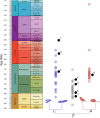Can We Reliably Calibrate Deep Nodes in the Tetrapod Tree? Case Studies in Deep Tetrapod Divergences
- PMID: 33193596
- PMCID: PMC7596322
- DOI: 10.3389/fgene.2020.506749
Can We Reliably Calibrate Deep Nodes in the Tetrapod Tree? Case Studies in Deep Tetrapod Divergences
Abstract
Recent efforts have led to the development of extremely sophisticated methods for incorporating tree-wide data and accommodating uncertainty when estimating the temporal patterns of phylogenetic trees, but assignment of prior constraints on node age remains the most important factor. This depends largely on understanding substantive disagreements between specialists (paleontologists, geologists, and comparative anatomists), which are often opaque to phylogeneticists and molecular biologists who rely on these data as downstream users. This often leads to misunderstandings of how the uncertainty associated with node age minima arises, leading to inappropriate treatments of that uncertainty by phylogeneticists. In order to promote dialogue on this subject, we here review factors (phylogeny, preservational megabiases, spatial and temporal patterns in the tetrapod fossil record) that complicate assignment of prior node age constraints for deep divergences in the tetrapod tree, focusing on the origin of crown-group Amniota, crown-group Amphibia, and crown-group Tetrapoda. We find that node priors for amphibians and tetrapods show high phylogenetic lability and different phylogenetic treatments identifying disparate taxa as the earliest representatives of these crown groups. This corresponds partially to the well-known problem of lissamphibian origins but increasingly reflects deeper instabilities in early tetrapod phylogeny. Conversely, differences in phylogenetic treatment do not affect our ability to recognize the earliest crown-group amniotes but do affect how diverse we understand the earliest amniote faunas to be. Preservational megabiases and spatiotemporal heterogeneity of the early tetrapod fossil record present unrecognized challenges in reliably estimating the ages of tetrapod nodes; the tetrapod record throughout the relevant interval is spatially restricted and disrupted by several major intervals of minimal sampling coincident with the emergence of all three crown groups. Going forward, researchers attempting to calibrate the ages for these nodes, and other similar deep nodes in the metazoan fossil record, should consciously consider major phylogenetic uncertainty, preservational megabias, and spatiotemporal heterogeneity, preferably examining the impact of working hypotheses from multiple research groups. We emphasize a need for major tetrapod collection effort outside of classic European and North American sections, particularly from the southern hemisphere, and suggest that such sampling may dramatically change our timelines of tetrapod evolution.
Keywords: fossil record bias; node age prior; phylogeny; prior constraint; tetrapod.
Copyright © 2020 Pardo, Lennie and Anderson.
Figures




References
-
- Ahlberg P. E., Clack J. A. (1998). Lower jaws, lower tetrapods–a review based on the Devonian genus Acanthostega. Earth Environ. Sci. Trans Royal Soc. Edinburgh 89 11–46. 10.1017/s0263593300002340 - DOI
-
- Anderson J. S. (2008). Focal review: the origin (s) of modern amphibians. Evol. Biol. 35 231–247. 10.1007/s11692-008-9044-5 - DOI
-
- Anderson J. S., Carroll R. L., Rowe T. B. (2003). New information on Lethiscus stocki (Tetrapoda: Lepospondyli: Aistopoda) from high-resolution computed tomography and a phylogenetic analysis of Aistopoda. Can. J. Earth Sci. 40 1071–1083. 10.1139/e03-023 - DOI
Publication types
LinkOut - more resources
Full Text Sources

